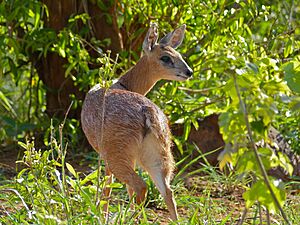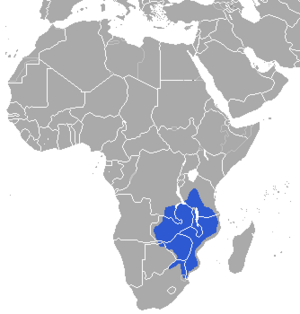Sharpe's grysbok facts for kids
Quick facts for kids Sharpe's grysbok |
|
|---|---|
 |
|
 |
|
| Male and female in the Kruger National Park | |
| Conservation status | |
| Scientific classification | |
| Genus: |
Raphicerus
|
| Species: |
sharpei
|
 |
|
| range | |
The Sharpe's grysbok (also called the northern grysbok) is a small, shy antelope. Its scientific name is Raphicerus sharpei. You can find these animals in parts of tropical and southeastern Africa. They usually live alone.
Contents
Where They Live
Sharpe's grysboks live in several African countries. These include South Africa (in an area called Transvaal) and Namibia (in the Caprivi Strip). They also live in Botswana, Mozambique, Zimbabwe, Zambia, Malawi, and Tanzania. You can find them all the way up to Lake Victoria.
What They Look Like
The Sharpe's grysbok is about the same size as a gray duiker. However, it has a stronger body. Its fur is shaggy over its back legs.
These grysboks stand about 45 to 60 centimeters (18 to 24 inches) tall at the shoulder. They weigh between 7 and 11.5 kilograms (15 to 25 pounds). Their coat is reddish-brown with white streaks. Their eyes, mouth, throat, and belly are off-white.
Horns and Teeth
Male Sharpe's grysboks have short, thick horns. These horns are set far apart on their heads. They have a short, deep snout with a large mouth. Their strong molar teeth help them grind tough food.
Their short neck and head on a long-legged body make them look high in the back when they are eating leaves.
How They Behave
Even though Sharpe's grysboks are found in many places, they are not seen very often. This is because they are very shy. Males and females might spend a short time together. But usually, you will only see one grysbok alone.
Marking Their Space
Sharpe's grysboks mark their territory using piles of dung. These are called dung middens. They also rub sticks with a special liquid from glands near their eyes. This tells other animals that the area is taken.
Where They Hide
They like to live in rocky hills. But they prefer the fertile areas on the lower parts of these hills. They are active at night, looking for food. During the day, they hide in tall grass or bushes to stay safe.
Running Away
Sharpe's grysboks are very timid. They will run away quickly if they sense danger. They run with short, bouncy hops. They keep running far away from the disturbance before they stop. This is different from steenboks, which often stop and look back. Sharpe's grysboks sometimes hide in burrows made by aardvarks.
What They Eat
Sharpe's grysboks eat leaves, buds, herbs, and fruits. During the dry season, their food can be very tough. Their strong teeth and jaws are perfect for this. About 30% of their diet is grass.
Taxonomy
The Cape grysbok (R. melanotis) is a close relative. It lives in the western Cape region of South Africa. Some scientists think that the Sharpe's grysbok is a type of Cape grysbok.


